Ancient druids of Wales
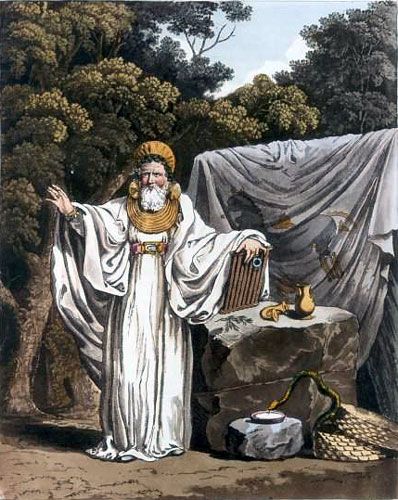
from Costume of the Original Inhabitants of the British Isles (1815) by Samuel Rush Meyrick and Charles Hamilton Smith.
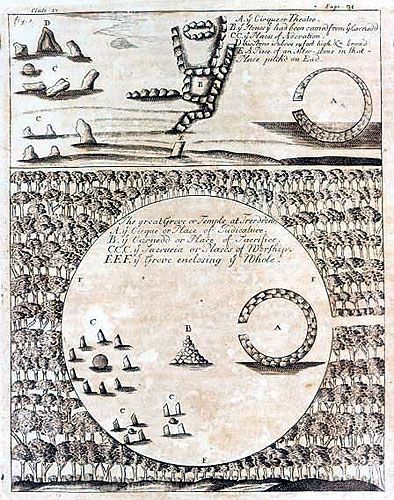
The alleged Druidical Temple of Tre'r Dryw (Anglesey) - prepared by the Revd Henry Rowlands (1723)
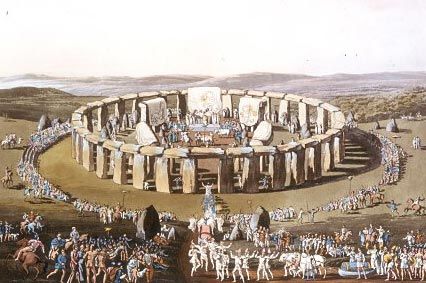
Early 19th-century speculation on how a Druidic ceremony might have appeared at Stonehenge. We now know that Stonehenge was built some 1,500 years before the first historical reference to the Druids.
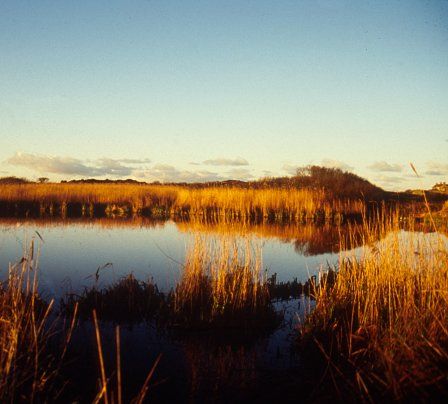
Llyn Cerrig Bach (Anglesey). A large quantity of Iron Age metalwork was found in this lake during 1943. [Image © Philip Macdonald.]
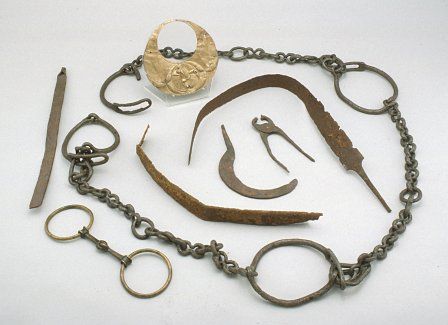
Selection of metalwork found in Llyn Cerrig Bach, including slave chains, bent swords, tools and chariot equipment.
Druids, the ancient priests of Britain and Ireland, have long intrigued and kindled the imagination of large popular audiences. The stereotypical image of the white-robed wise man, carrying perhaps a golden sickle and mistletoe, or clasping a white staff, remains strong with us today, the outcome of many centuries of thinking and invention. Yet what evidence do we have for these powerful but elusive figures?
The earliest mention of Druids comes during the 1st century BC, referring to druidae in Gaul (France) and Britain, who were wise men, observers of natural phenomena and moral philosophers. Similar to the druids were the bards (bardoi) - singers and poets, and diviners (vates), who interpreted sacrifices in order to foretell the future.
Druids and bards were common in medieval Welsh and Irish texts, probably giving account of much earlier oral tradition, passed on by word of mouth.
The visual appearance of druids - what they wore and what possessions they owned - is difficult to clarify. There are few illustrations or inscriptions of the time, whilst archaeology rarely provides certain answers. A druidic ceremony described by Pliny, in his Natural History, describes a white-robed druid climbing an oak tree to cut down mistletoe with a golden sickle.
Hywel Dda
In Wales, the roles and privileges of bards related to laws set down by Hywel Dda in the 10th century AD. During the 18th century, druids came to be seen as the ancestors of the bards, the praise poets, musicians and genealogists, who flourished in Welsh medieval society.
Human Sacrifice
A revival of interest in druids began during the Renaissance (14th to 16th centuries), when translations of Classical Greek and Roman texts became widely available. A number of sources describe the druids as performing human sacrifice. Places of worship were described as isolated wooded groves and near sacred pools and lakes. According to one source, the druidic groves on Mona (Anglesey) had the blood of prisoners drenched upon their altars.
Stonehenge
Some accounts suggested that the stone circles at Avebury and Stonehenge had been druidic temples. Similarly, a number of megalithic monuments on Anglesey were thought to be the temples and sacrificial altars of druids. However, with advances in archaeological understanding during the 19th century, it became clear that these monuments were built over 4,000 years ago, long before the appearance of druids. Nevertheless, modern druids and bards continue to meet within stone circles today.
Celtic rituals of the Iron Age
Archaeology does, however, provide evidence for the religious expression of Celtic Iron Age people. The tradition of offering gifts to the gods is well illustrated at the site of Llyn Cerrig Bach on Anglesey. Here, between 300BC and AD100, chariots, weapons, tools and decorated metalwork items were cast from a causeway or island into a small lake. Coincidentally, an account by the Roman author Tacitus vividly recounts the crushing of a druidic stronghold on Anglesey by the Roman army, leading some to infer that Llyn Cerrig Bach was a druidic site.
Other instances of Celtic Iron Age ritual have also been identified. For example, a probable sacrificial victim preserved in peat has been found at Lindow Moss in Cheshire (England). Recently, the famous Cerrig-y-Drudion bowl, elaborately decorated in the Celtic or La Tène art style, has also been convincingly interpreted as a ceremonial crown. This and a number of other crowns and regalia, found with burials or in temples in Britain, may have denoted priestly office.
In this prehistoric world, the power of the pagan Celtic gods was keenly felt, ever present and intermingled within everyday life.
Anglesey
The druids have long been associated with Anglesey in popular imagination. The historical evidence upon which this association is based is an account by the Roman author Tacitus, who wrote of the Roman conquest of Anglesey:
"On the beach stood the adverse array [of Britons], a serried mass of arms and men, with women flitting between the ranks. In the style of Furies, in robes of deathly black and with disheveled hair, they brandished their torches; while a circle of Druids, lifting their hands to heaven and showering imprecations, struck the troops with such an awe at the extraordinary spectacle that, as though their limbs were paralysed, they exposed their bodies to wounds without an attempt at movement. Then, reassured by their general, and inciting each other never to flinch before a band of females and fanatics, they charged behind the standards, cut down all who met them, and enveloped the enemy in his own flames. The next step was to install a garrison among the conquered population, and to demolish the groves consecrated to their savage cults; for they considered it a pious duty to slake the altars with captive blood and to consult their deities by means of human entrails." (Translated by John Jackson, published by William Heinemann, 1951).
Background Reading
Druids by A. Ross. Tempus Publishing (1999).
Exploring the World of the Druids by M. J. Green. Published by Thames & Hudson (1997).
Shrines & Sacrifice by A. Woodward. Published by Batsford (1992).
Tacitus: the annals By J. Jackson. Published by William Heinemann (1951).
The Bog Man and the Archaeology of People by D. Brothwell. British Museum Publications (1986).
The Druids by S. Piggott. Published by Thames & Hudson (1968).
Comments - (19)
and maes y hir gad , meaning field of the long army.
If you look at the course of the river braint on the map you can see the groves called llwyni in welsh . they amass around the braint , so do ancient monuments such as bryn celli ddu.
hope u can help....
goodbye......
Hi Jake - just to update you of our Librarian's response:
You will find more information about interpretations of Anglesey's archaeology in this blog post: Mona Antiqua Restaurata
You might also want to contact Elizabeth Walker, who might be answer more specific questions you might have.
Best
Sara
Digital Team
Hiya Jake
Thanks for your comment - I'll pass this on to our librarian and get back to you. It may be that we have the volume in our collections. The National Library of Wales may also have a copy - it would be worth searching their catalogue to see if it available or if it has been digitised.
Broadly speaking, most of the antiquarian writing about Anglesey's druid culture from this period is in no small part related to the island's rich Neolithic archaeology. Find out more about the tombs of stone-age Wales, or the Neolithic in Anglesey.
Best wishes,
Sara
Digital Team
I am currently in my final year of my masters degree in Architecture with my project sited in Anglesey. I have been looking into the historical background of the area and came across an online article on your website regarding the ancient druids of Anglesey, More specifically the image of "The alleged Druidical Temple of Tre'r Dryw (Anglesey) - prepared by the Revd Henry Rowlands (1723)". Would there be anyone that could give me an explanation of this image as to the different elements of the structures? this will hugely benefit the concept of my project and will be hugely appreciated!
thank you,
Jake Scargill
No-one until now has been able to tell us what the Dodecahedron device was used for or the intricate mathematics associated with it. The Dodecahedron was previously known as "Roman" but has now been verified to be Druidic in origin. The deciphering of this ancient artifact has recently been completed and is available to read in full at the following link http://www.celticnz.co.nz/Dodecahedron/Decoding%20the%20Druidic%20Dodecahedron1.html
I will be very interested to hear back from you with your feedback and if you could also forward this information on to your Druidic associates
Thanks for letting us know about your badges - could you please post another comment with the 'email' field completed - so that I can send your enquiry on to a curator? Your email won't appear on the website - it just means that the curator will be able to see it to get in touch and possibly see pictures of the items in question.
Many thanks,
Sara
Digital Team